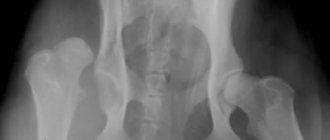The owner's word is law. And if not?
Breeders often turn to professional trainers with the following complaint: the dog does not obey or has stopped responding to the owner’s commands, the puppy runs away in the street and snaps. What to do if this happens, why, how to make the animal obey, re-educate it. First of all, the owner needs to do the following - find out the reasons for disobedience. They can be varied:
- The pet may not obey if it is currently experiencing pain. His lethargic appearance, lack of activity and energy, and refusal to eat will also indicate the beginning of the disease.
- In uncomfortable conditions, the puppy may also not obey the owner (for example, if it is very hot or, conversely, cold).
- If the dog has stopped following the owner's commands, assess its condition: perhaps it is physically tired.
- An animal does not respond to commands when it is afraid of something.
- Improper training and harsh treatment of an animal can also cause it to disobey its owner.
- The animal can be affected by distractions. The puppy unquestioningly followed commands at home or on the street in a quiet and calm environment, but suddenly stopped obeying its owner in a busy place. The situation when a dog is prevented from concentrating by extraneous noises is not uncommon.
- The animal can be spoiled. Lack of training leads to the fact that the dog becomes uncontrollable, snaps, bites and interferes with the quiet life of the whole family. Not only large breed dogs need to be raised, but small ornamental pets also need to be taught the rules of behavior and some commands.
- Dominant animal. If a dog has a dominant desire to dominate, getting him to obey is quite difficult.
Why doesn't a dog obey on the street, although it obeys at home or on the playground?
The reason why a dog does not obey on the street, although it perfectly follows commands at home or on the playground, is simple. As a rule, in this case it turns out that the owner works with her exclusively at home or at the training ground. And this is absolutely not enough.
The fact is that dogs are bad at generalizing.
. This means that if you taught your pet the command “Come to me” or “Near” on the playground, it is obvious to the dog that this command must be executed there. And another place means different conditions and other stimuli, which for a dog is a significant increase in complexity. It is too difficult for her to concentrate on her master's demands. In fact, for a dog this is practically a different command, which means that it is not at all a fact that the dog will carry it out.
Even if you are used to giving a command, for example, with a right hand gesture, and suddenly decide to use a left hand gesture, a dog that is not accustomed to such changes may not understand what you want from it.
So a dog does not obey on the street not because it is “bad” or acts “out of spite.” She simply doesn't understand what you want and/or is unable to concentrate on you.
Photo: pixabay.com
How to deal with a disobedient dog
Having figured out the reasons why the animal does not listen, you should move on to action. A dog that does not obey must be trained and forced to follow the owner's commands.
Here are some tips on how to do this.
- Don't neglect education. Strict rules and owner leadership are essential for successful training. A dog that respects its owner and recognizes his leadership will definitely obey.
- Training. If the owner cannot cope with the pet himself, he should turn to professionals. If a puppy runs away and snaps, that’s one thing, but when an adult dog (especially large breeds) does this, it’s already dangerous. Therefore, you should not neglect training, so that there are no problems in the future. And you need to seek help right away, since it is very difficult to retrain a dog that has been improperly trained.
- It is very important to train not only at home, but also to teach the dog to obey on the street, where there are many distractions. You can train the animal slowly, first without letting it off the leash (you can use a long one for such purposes), in busy places.
- A dog that stops following its owner's commands or bites must be adequately punished. Ideally, the punishment for a pet is the lack of positive attention from the owner, the command “Fu”. But to do this, you first need to establish close contact with the animal and earn its love and devotion. It is always necessary to punish during the offense, not after, so that the animal understands where it was wrong. However, remember: physical punishment is unacceptable. You can slap your hand on the rump or, if the dog is on a leash, pull it back.
- There should always be consistency in training so that the dog understands what can be done and what cannot be done. That is, if you forbid an animal to do something, you should always do it. If you ignore him even once, the puppy will understand that he has options for behavior.
- Among other tips, a long and active walk will help you cope with a dominant dog. If the animal is busy on a walk, then at home it will not have the strength and desire to resist and show character.
- Dose affection. An animal should not be overly pampered or comforted when it behaves incorrectly. Affection should be a reward for correct and good behavior. If you teach your pet to do this from childhood, then the lack of friendly stroking on the part of the owner will be a significant punishment in the future.
Often, owners do not notice the pet’s minor offenses or ignore them. Think about what will happen if the animal does not respond to the owner’s call once? But a dog that commits minor offenses may sooner or later begin to commit more serious ones. It will be difficult to re-educate her. Therefore, unwanted behavior cannot be reinforced. And small offenses should signal the owner about an approaching problem. If the dog has ever stopped obeying, pay attention to it now, so that later it is not too late.
How to properly punish a dog
Punishment is one of the effective methods used for educational purposes, in teaching and training. However, not everyone knows how to properly punish a dog. For example, strict intonation and a stern look are enough for impressionable pets, but physical punishment is unacceptable.
A rude attitude can make a dog angry. With this approach, the puppy can grow up timid and cowardly. If you constantly shout, scold, and even more so beat your dog, it will stop seeing you as an authoritative leader.
Methods of punishment:
- reprimand, strict intonation;
- jerk of the leash;
- ignoring;
- effect of surprise (loud bangs, unexpectedly flying foreign objects);
- shaking by the scruff of the neck, light slaps with a rolled-up newspaper.
Any influence on the dog due to incorrect behavior must be accompanied by prohibition commands (“fu”, “no”). Only punish your dog when you catch it in the act. Dogs do not know how to think logically and if you miss the moment, the punishment will not be effective, the dog will not understand why he was scolded or hurt.
Features of raising dogs with dominant behavior
Among animals there are individuals with a desire for leadership and dominant behavior. The puppy proves that he is the leader to his brothers. He will also want to dominate in the master's family. The dog does not obey, runs away or bites - all these can be signs of this nature. From an early age, from the first days a pet appears in the house, the owner must make every effort to make sure that the animal understands who is in charge. What to do if the dog doesn't listen? It is necessary to re-educate her, teach her to listen to her owner’s commands. It’s easier to teach an animal this at a young age. So, the pet should have its own place to sleep in the house, attempts to climb onto the sofa or bed should be stopped immediately. The owner must teach the puppy to carry out hygiene procedures without aggression (trimming nails, bathing, etc.). Training is required. It is necessary to teach the commands “Fu”, “No”. No exceptions should be made for representatives of decorative or small breeds. A dog that does not obey its owner causes a lot of trouble. And it doesn’t matter so much whether it’s big or small.
Typical mistakes when training
Let's consider what behavior a dog owner should avoid when training, so that there are no problems with the pet in the future.
- Cruelty to animals is not acceptable.
- Frequent repetition of the command. This is a mistake many owners make. The command must be given only once. Otherwise, the pet will get used to doing it the fifth or tenth time.
- Inaction when a command is not executed. The animal will regard such connivance as weakness and an opportunity to continue not to carry out the command at will.
- Praise and shouting are of the same tone. The emotional coloring should be different when punishing and praising.
- The conditioned stimulus (that is, the command) should always precede the unconditioned stimulus (for example, a jerk of the leash).
- Adjustment for the animal. You should not adjust if your pet has followed the command, but not completely. For example, you do not need to approach a dog that came to the command “Come to me”, but sat down about three meters from the owner. You need to ensure that the command is executed correctly.
The dog does not obey - many owners face this problem. Why and how to teach and make sure that the owner’s word is law. First of all, you need to pay attention to yourself. A dog that does not follow commands is not at fault. She was trained incorrectly. Find out the reasons why the dog does not obey, reconsider your training strategy. After this, it will be easier to draw conclusions and teach a dog that has stopped following commands to listen to its owner. Understanding the reasons is the first step to solving the problem. And remember, a dog can be taught anything. The main thing is to know how and to do it correctly.
What not to do - the main mistakes of novice breeders
If a dog does not obey the owner, does not respond to prohibitions, or behaves inappropriately on the street, the owners are often to blame for such pet behavior.
What not to do - the main mistakes of novice breeders:
- Encouraging your pet to misbehave. You can't follow the dog's lead. A dog who does whatever he wants will feel like a dominant leader. And this cannot be allowed. From puppyhood, the dog must understand what is allowed to do and what is not.
- The dog should not sleep on the bed or chairs. In nature, only the leaders can rest at higher elevations.
- Do not allow your dog to show aggression towards household members or strangers. Immediately stop attempts at such behavior.
- Feed the dog only after you and the whole family have eaten. During lunch and dinner, it is best to kick your pet out of the kitchen. Don't give treats from your table.
- Not a properly organized training system. If a dog handler is working with a dog, the owners must systematically practice and consolidate the skills acquired on the training ground. Choose different places to study.
- Teaching a dog several commands at the same time. Training must be consistent. Only after the dog has memorized one command well, start teaching others.
- Do not adapt to the dog, do not make concessions during training. Always get your dog to complete the task to the end.
- Frequent repetition of the command. The command must be given only once with strict intonation. Otherwise, the dog will do it when it sees fit.
- Same intonation for reward and punishment. Dogs may not understand human language, but they are great at picking up intonations and feeling our emotions.
- Lack of adequate punishment. If a dog bites, shows aggression, turns the apartment upside down in the absence of the owners, the dog must be punished and this must be done while committing the offense. This does not mean that the animal should be beaten. Physical violence is unacceptable. Shout at the dog, lightly slap him on the rump, pull the leash. The ideal punishment is lack of attention from the owner.











